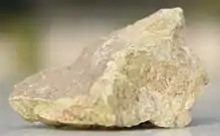Epidosite
Epidosite (/ɪˈpɪdəsaɪt/) is a highly altered epidote and quartz bearing rock.[1] It is the result of slow hydrothermal alteration or metasomatism of the basaltic sheeted dike complex and associated plagiogranites that occurs below the massive sulfide ore deposits which occur in ophiolites.[2][3] Most epidosites represent the zone of intense metal leaching below and lateral to the sulfide deposits which is the result of convection of heated ocean water through the fractured basalts of the sheeted dikes.[2][3]

Sample of Epidosite
References
- Peter T Flawn (1951). "Nomenclature of epidote rocks". American Journal of Science. 249 (10): 769–777. Bibcode:1951AmJS..249..769F. doi:10.2475/ajs.249.10.769.
- Banerjee, Neil R., et. al., Discovery of epidosites in a modern oceanic setting, the Tonga forearc, Geology, February, 2000 v. 28, no. 2, p. 151-154
- Lori Bettison-Varga, Robert J. Varga and Peter Schiffman, Relation between ore-forming hydrothermal systems and extensional deformation in the Solea graben spreading center, Troodos ophiolite, Cyprus, Geology, 1992, v. 20 no. 11 p. 987-990
External links
- . Encyclopædia Britannica. 9 (11th ed.). 1911.
- http://www.mindat.org/glossary/epidosite
This article is issued from Wikipedia. The text is licensed under Creative Commons - Attribution - Sharealike. Additional terms may apply for the media files.
